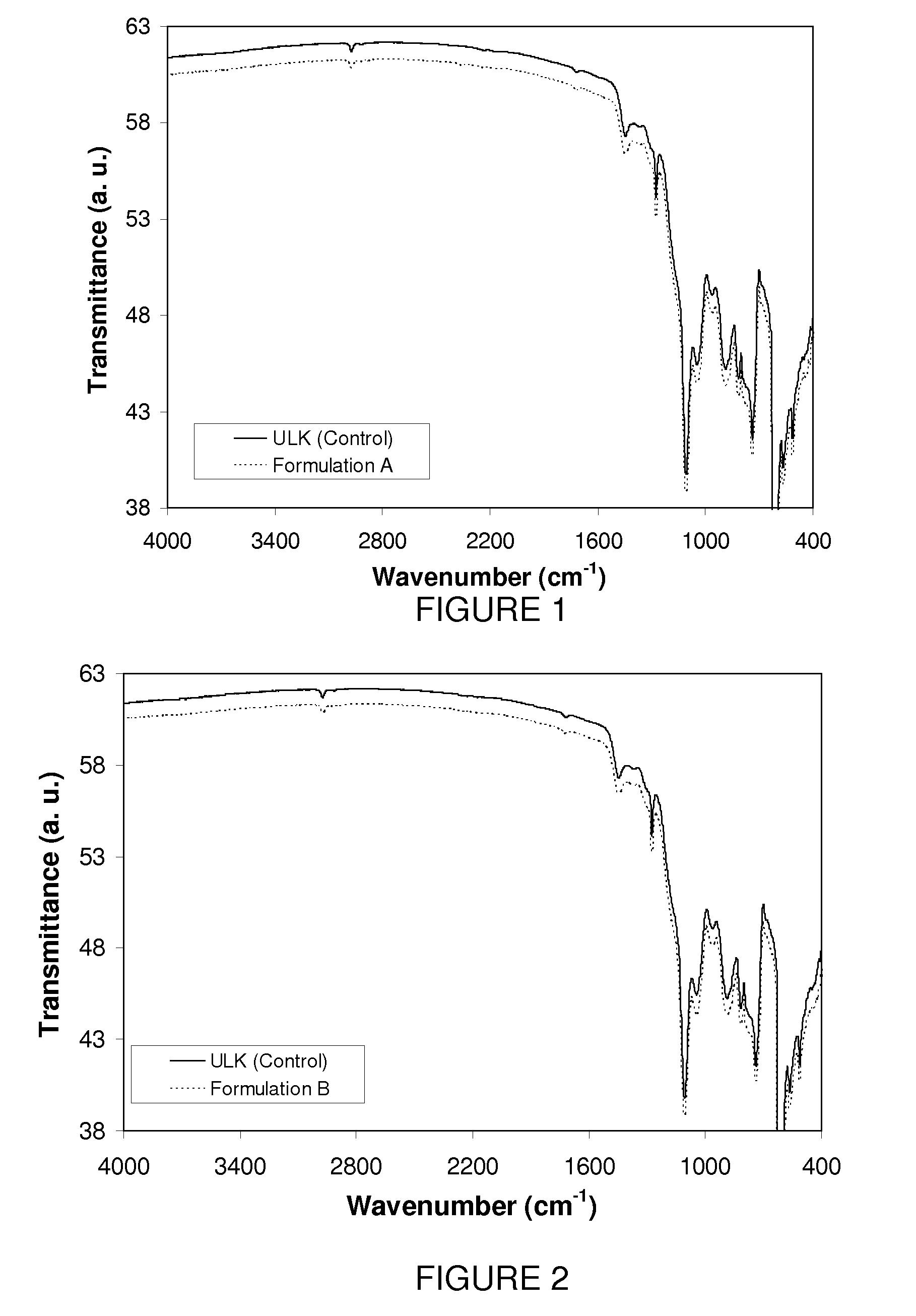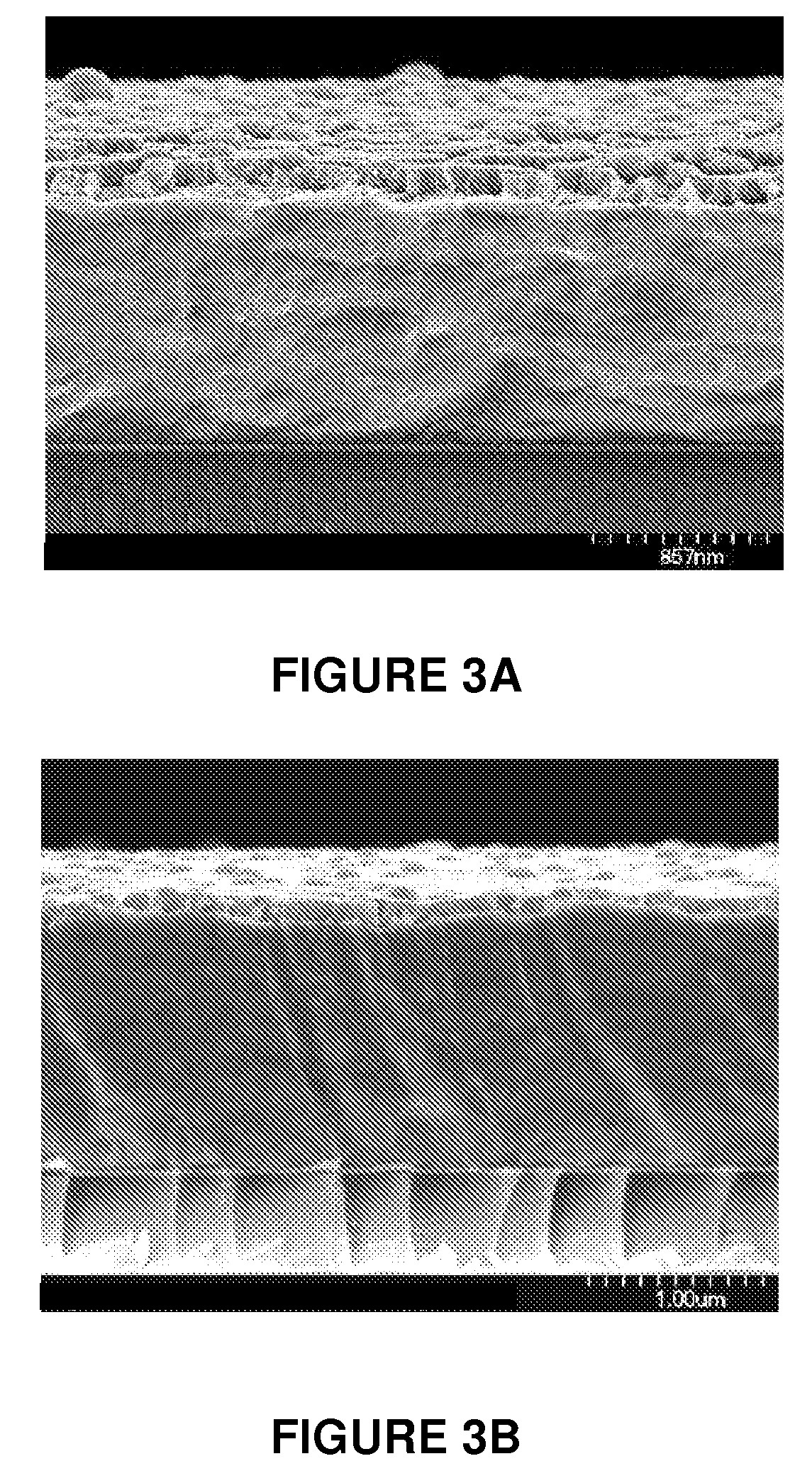Liquid cleaner for the removal of post-etch residues
a liquid cleaner and residue technology, applied in the preparation of detergent mixture compositions, detergent compounding agents, inorganic non-surface active detergent compositions, etc., can solve the problems of corroding metal structures, increasing the dielectric constant, and interfering with subsequent silicidation or contact formation
- Summary
- Abstract
- Description
- Claims
- Application Information
AI Technical Summary
Benefits of technology
Problems solved by technology
Method used
Image
Examples
example 1
[0118]The etch rates of blanketed ULK, titanium nitride, Cu and W in Formulations A-H was determined. The thicknesses of the blanketed materials were measured before and after immersion in Formulations A-H at 50° C. Thicknesses were determined using a 4-point probe measurement whereby the resistivity of the composition is correlated to the thickness of the film remaining and the etch rate calculated therefrom. The experimental etch rates are reported in Table 1.
TABLE 1Etch rate of ULK, TiN, Cu and W in Å min−1after immersion in Formulations A-H.Etch rate / Å min−1FormulationULKTiNCuWA0000B0000C0000D0000E0000F0000G0000H0002.2
[0119]ULK compatability studies were also performed using Fourier Transform Infrared Spectroscopy (FTIR) and capacitance data. It can be seen in FIGS. 1 and 2 that no observable changes were observed in the ULK contacted with formulations A and B, respectively, relative to the ULK control, especially in the 2800 to 3000 cm−1 hydrocarbon absorption region, which sug...
example 2
[0120]The etch rates of blanketed ULK, titanium nitride, Cu and W in Formulations AA and AB was determined. The thicknesses of the blanketed materials were measured before and after immersion in Formulations AA and AB at 50° C. Thicknesses were determined using a 4-point probe measurement whereby the resistivity of the composition is correlated to the thickness of the film remaining and the etch rate calculated therefrom. The experimental etch rates are reported in Table 3.
TABLE 3Etch rate of ULK, TiN, Cu and W in Å min−1 afterimmersion in Formulations AA and AB.Etch rate / Å min−1FormulationULKTiNCuWAA0000AB0000
[0121]ULK compatability studies were also performed using FTIR and capacitance data. No observable changes were observed in the ULK contacted with formulation AB, relative to the ULK control, especially in the 2800 to 3000 cm−1 hydrocarbon absorption region, which suggests that organic impurities did not absorb to the ULK. The capacitance data, as determined using an Hg probe,...
example 3
[0123]The etch rates of blanketed ULK, titanium nitride, Cu and W in Formulations AC-AK was determined. The thicknesses of the blanketed materials were measured before and after immersion in Formulations AC-AK at 50° C. for 65 min. Thicknesses were determined using a 4-point probe measurement whereby the resistivity of the composition is correlated to the thickness of the film remaining and the etch rate calculated therefrom. The experimental etch rates are reported in Table 5.
TABLE 5Etch rate of ULK, TiN, Cu and W in Å min−1after immersion in Formulations AC-AK.Etch rate / Å min−1FormulationULKTiNCuWAC001.50AD000.20AE0000AF0000AG001.20AH0000AI——6.30AJ——2.60AK——2.40
[0124]ULK compatability studies were also performed at 50° C. for 65 min using FTIR and capacitance data. The capacitance data, as determined using an Hg probe, is reported in Table 6. The post-bake step, when applicable, was performed at 200-210° C. for 10 minutes.
TABLE 6Capacitance of ULK control relativeto ULK immersed i...
PUM
| Property | Measurement | Unit |
|---|---|---|
| dielectric constant | aaaaa | aaaaa |
| weight percent | aaaaa | aaaaa |
| weight percent | aaaaa | aaaaa |
Abstract
Description
Claims
Application Information
 Login to View More
Login to View More - R&D
- Intellectual Property
- Life Sciences
- Materials
- Tech Scout
- Unparalleled Data Quality
- Higher Quality Content
- 60% Fewer Hallucinations
Browse by: Latest US Patents, China's latest patents, Technical Efficacy Thesaurus, Application Domain, Technology Topic, Popular Technical Reports.
© 2025 PatSnap. All rights reserved.Legal|Privacy policy|Modern Slavery Act Transparency Statement|Sitemap|About US| Contact US: help@patsnap.com



